In my mind, the April 19 Diablo Trails Challenge 50K ranked as a “B” race—a last long training run and stepping stone to the “A” race of the Miwok 100K just two weeks away on May 3. I signed up mainly because I didn’t want to miss an outstanding opportunity to traverse Mount Diablo in springtime.
After the blessed February and March rains, Mount Diablo’s wind-swept grasslands turned green, and the purple lupin and orange poppies blossomed in abundance. April is the prettiest month on the mountain, a too-brief fraction of a season before the sun bakes it yellow-brown again. This event is extra special because it provides the opportunity to run from the east side, in the Round Valley Regional Preserve, 31 miles west across the southern side of the summit to Castle Rock Park. Normally I do out-and-back runs on Mount Diablo starting at Castle Rock or Mitchell Canyon, and I hardly ever drive all the way over to the east side, so this point-to-point is a real treat. The course doesn’t go all the way to the summit, but it gains about 7000 feet of elevation nonetheless (see here for map and elevation chart).
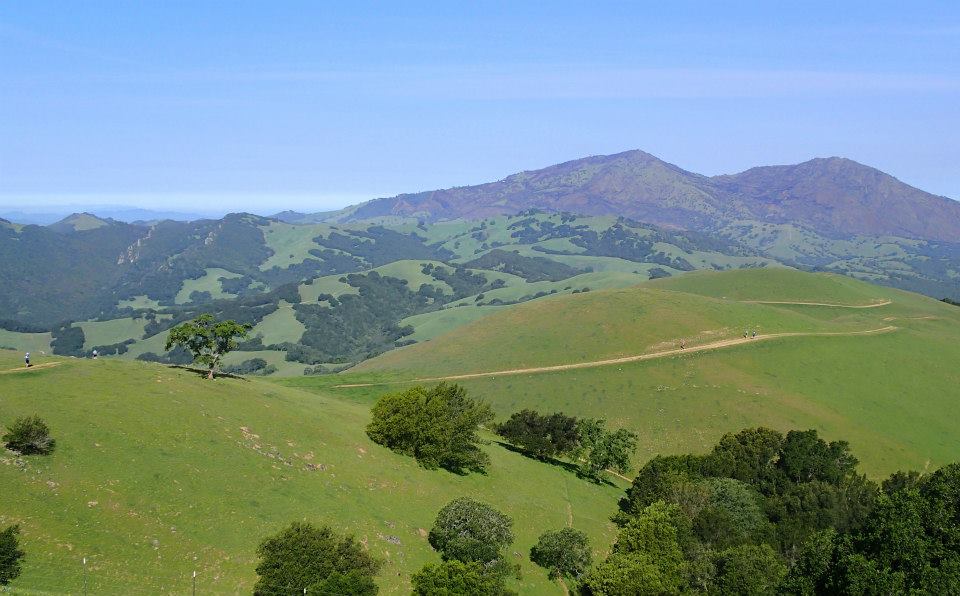
A glorious stretch of trail on the first half of the Mount Diablo 50K, with the summit and north peak in the distance. The finish line is on the other side of the summit’s ridge line. Photo by Alvin Lubrino
This event, directed by Brazen Racing, benefits Save Mount Diablo, an organization that our household has supported since the late 1990s. Since its founding in 1971, the group has preserved over 100,000 acres of open space in 40 different parks. In fact, we wouldn’t have been able to run out of the Round Valley starting area if not for SMD, because 15 years ago the area was slated to be developed as a dump. Kudos to the race organizers for sharing this information with all the participants as we rode shuttle buses to the start. The event prompted a lot of individuals to fundraise for Save Mount Diablo, and about 10 percent of the registration fees were donated to the organization. It seems like a no-brainer that more race directors should partner with conservation groups for trail events so the groups can get their message out to participants and benefit from the fundraising.
The Training
I had a compressed training cycle to get ready for this event and for Miwok, so I’ve had to be quite careful and efficient. All of January was a rehab month post-injury, running very short distances in between a lot of walking and cross-training. My weekly mileage back then totaled only 15 to 20. That left only 12 weeks from February through April to train (not including a two-week taper at the end of April). How could I get ready for a 100K by May 3?!
In February, I worked on rebuilding a base and got my mileage up to 35 – 40 per week, along with a weekly spin class and twice-weekly strength training with an emphasis on core and physical therapy exercises for my back and foot. I ran a 30K (18.5-mile) trail race mid-February that was my longest and hardest run of the new year.
In March, I reintroduced longer runs and a little bit of moderate speedwork, and I stopped the weekly spin class to run during that time instead. My weekly mileage grew from 45 to 65. I still went to the gym a couple of times a week for strength training and PT. I did four significant long runs in that month: a 34-mile slow group fun run/hike (Eldrith’s wonderful “Uncool 50K”); the Night Sweats nighttime marathon that I ran as hard and fast as I could; another marathon-length training run at a conversational pace; and a steady-effort 35-mile solo training run. I also did a medium-length (1.5 to 2 hour) run each mid-week during which I’d try to run 20 – 30 minutes at what felt like a tempo pace, and I started doing strides (six repeats of 30-second accelerations to sprint followed by 30 seconds of rest) for warmups and cool-downs once or twice a week.
As I ramped up my training in March, I really tried to keep injury prevention front and center in my mind. That meant icing my foot after runs, swimming to relieve my muscles the day after a long run, and mostly, SLEEP. I’ve been going to bed around 9:30 and shifted running to afternoons on several days so I can wake naturally, around 6:30 a.m., rather than at 4:30 or 5. I find it very challenging to get out the door and run in the afternoons, when I’m dealing with other stuff that needs to get done, but running in the afternoon and getting extra sleep really seemed to help.
The Race
I didn’t think of the Diablo Trails Challenge as a race but rather as a pre-Miwok reality check and final long, hard run before tapering. My goals were: to run steadily; to practice nutrition and hydration so I never felt bonky or bloated; and to aim for an average pace of 11 to 11:30 per mile to build confidence for running Miwok at around a 12-minute average pace. (I know this will sound slow to any road-runner who might be reading this, but keep in mind that my pace slows to 15 to 20 minutes/mile on steep uphills that require hiking.) The women’s course record for the Diablo 50K was 5:22 (a 10:12 average pace), set by Katie Murphy, 31, from San Ramon. She was back to run again this year, so I predicted she’d try to beat her record and would win.
I ran the Diablo Trails Challenge 50K in 2009, its inaugural year, but the course was a couple of miles extra long and extra muddy that year, so I finished in 6:09. Knowing that the women’s CR was 5:22 gave me a better idea of the course difficulty, and I thought I’d aim for 5:45 if I felt well (just under an 11-minute average pace).
We had a delayed start because Brazen goofed getting the bib numbers to the starting area in time, and they also forgot to bring safety pins. Some people seemed kind of bent out of shape about the wait, but I didn’t mind—I felt relaxed and had fun talking to friends.
Once the bib numbers arrived, though, we all had to scramble, at which point I felt momentarily discombobulated. I didn’t know where to put my bib number since I had no safety pins (I shoved it in a pocket); I made a last-minute decision not to wear my hat and to have a buff headband instead, since it was windy and I wanted to keep hair out of my face and not worry about my hat blowing off (wise choice), so then I had to shove my hat in my hydration pack; and my pack felt weird because I was experimenting with using a bottle in the front pocket. The bottle-in-front idea was prompted by Miwok, which will be a cup-less race to reduce waste, so we’ll need an easily accessible container to drink from and refill at aid stations. Turns out, I like using the front pocket for the bottle rather than a hand-held so I can keep my hands free.
Oh, and of course, I had to pee again! My friend Karen Gerasimovich captured the moment in this photo at the starting line, as I struggled to get the pack on and avoid having an accident:
The early miles of the race were gentle, rolling and gorgeous—wide-open emerald pastures with oak woodlands. With soft footing below and blue sky above, I felt so good that I worried about going out too fast. I laughed when some doofus nearby complained about the strong wind—the same guy who showed off by jumping over a fence rather than running through the gate. I doubt he had ever run Diablo in the rain, mud or snow, or else he would have appreciated these mud-free, mild conditions.
I held myself back to a comfortable pace, which in the early, flatter miles was in the 9 to 10 minute range, and I began chatting on an uphill with a nice guy who had an accent and said he’s from the Czech Republic. I took it upon myself to play tour guide and talk about the wonders of Mount Diablo. I later found out his name is Marek Moskor.
He took this lovely photo of the early miles through Morgan Territory:
And he wrote about me in his race report! Here’s his paragraph, followed by Google Translate’s unique interpretation:
První část trati vede mezi stromy přes louky, na kterých se pasou hovězí plemena Angus. Příznivci dobrého steaku vědí. Hliněná cesta se divoce vlní už od prvních metrů, je třeba dávat pozor na častou erozi a kraví koláče. Protože neznám podrobný profil trasy, rozhodl jsem se v počátku držet běžců, kteří budou mít podobné počáteční tempo jako já. Kus cesty běžím se Sarah Lavender Smith která píše hezký blog.
The first part of the route leads through the trees across the meadows where grazing Angus beef breeds. Fans know a good steak. Dirt road undulates wildly from the very first meters, it is necessary to pay attention to frequent erosion and cow pies. Because I do not know the detailed route profile, I decided in the beginning to keep runners who have similar initial pace as me. Long way to run with Sarah Lavender Smith who writes a nice blog.
Thanks, Marek!
During the first half, I tried to keep two women who were ahead of me within sight. They were always about a quarter mile or so ahead; a couple of times I would start to close the gap on the uphills, but then they ran faster and out of view on the downhills. It felt more like a game at that point than a race; I didn’t think I’d close the gap, but I didn’t want to lose sight of them.
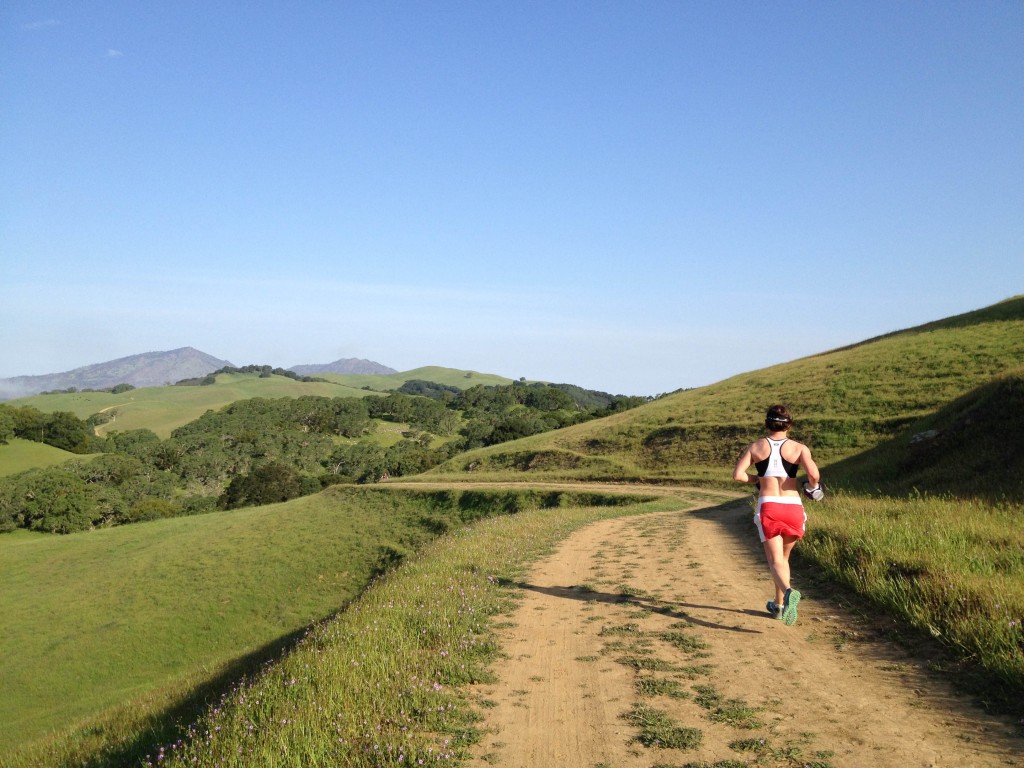
Marek’s photo of Justine Owen, one of two women who were ahead and within sight during the first half of the race.
Approaching the Mile 16 aid station—the second of only four aid stations—the course follows an out-and-back spur for about a half mile that allows runners to see who’s ahead and who’s behind them. The first woman I saw coming toward me as I approached the aid station was someone named Lisa, who looked super strong and determined, so I knew it was highly unlikely I’d see her again. Katie Murphy, the course record holder, was nowhere to be seen, so I figured she must be way out in front. I glimpsed one of the women whom I’d been following more closely as she ran out of the aid station—Justine Owen—and she looked a bit tired. Then, right as I approached the aid station, I caught up to the other woman whom I’d been tailing, Julienne Neumann. She did not seem very happy as she chucked her gloves in the trash can and shook her head when a friend asked how she was doing. She ran off while I lingered at the aid station to eat and refill my bottle. From what I could gather, I was in fifth place at the halfway point.
After the aid station, the course transitions from fire road to a narrow, uphill single track that cuts through tall grass and woods with uneven footing. I was on my own at that point, no one else in sight, and I decided to work hard on that stretch to practice the section of the Miwok race that I always find hard: the grassy, slanted single-track Coastal Trail. I pushed through Mile 18 in this shady grove of bay laurel and buckeye and suddenly spotted Julienne up ahead. I caught up but didn’t feel strong enough to pass her decisively, so I ran behind her and made small talk for a minute until I realized she wore headphones and couldn’t hear me. Pretty soon she moved to the side, and I passed.
Only a minute or two later, I rounded a corner and was surprised to see Justine, who looked like she was struggling. I passed her and surged a bit to open a gap between us. Having so unexpectedly and quickly passed the two women I’d been following all morning, I didn’t want to get passed back.
At that point, around Mile 20, I found myself in third place and made a decision: I was going to race, not just run, the rest of the way. Rather than going out too hard or stressing out competitively (as I often do in races), I had managed to run the first two-thirds in a steady and relaxed just-right pace that positioned me to finish strong with a negative split.
I got down to business and focused on making the most of each stretch of the trail while concentrating on good turnover to prevent overstriding. I also made a conscious decision to consume more Gu and Honey Stinger chews—close to 300 calories per hour, more than I normally do—since I could feel my furnace burning through fuel on those uphills. I was so stoked to be the one doing the passing, rather than getting passed, that I didn’t want anyone—female or male—to pass me, so I tried to open a gap each time I passed a guy too.
After the third aid station at Mile 23, I knew the course well and could run hard on the downhill stretches to average around a 9-minute pace, but I couldn’t recall how hard the final hill at Mile 27 would be. It turns out it’s a 500-foot climb, and after pounding my quads downhill for four prior miles, it hurt a lot, and my pace slowed to 15 minutes on that segment.
I reached the final aid station at Mile 28, had one last Gu, and decided to run the last 5K as hard as I could. I looked at my watch and calculated that 5:30–yes, 15 minutes faster than I originally estimated!–was within reach, if I tried my best.
So I did, I’m proud to say—this is one of those races where I left nothing behind. There was only one problem, however. The race is 31.6 miles long, and I did the math in my head as if it were 31 miles even. Nooooo!
I realized my error as I sprinted along the canyon toward the finish (“sprinted” loosely defined—after 29 miles, an 8:22 pace on the trail feels blazing fast). As my watch approached 5:30, I knew I had at least a half mile left and would not make it. Darn. But I didn’t slow down because there was some guy named Eric who caught up to me at the last aid station, and did I mention that I did not want to get passed?
I would’ve made my revised goal of breaking 5:30 if the course were 31 miles, but I was quite happy with 5:32:28, a 10:28 average pace. Katie Murphy smashed her old course record by 20 minutes, in 5:01:57. The second-place woman was totally beyond my reach too; Lisa Hughey finished in 5:12. But I was happy to earn and then hang onto 3rd, which also was 1st for my age group and 13th overall. San Francisco Running Company’s Brett Rivers had an incredible record-setting win in 4:06, a 7:46 pace. (Results.)
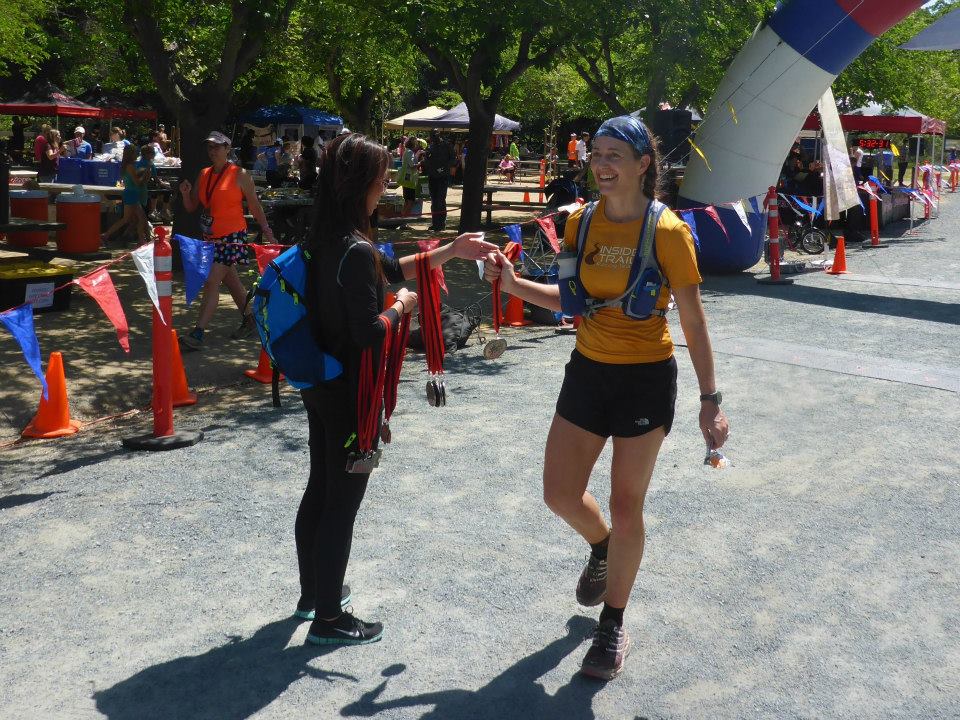
Happy to finish, holding the crumpled bib number that I never pinned on in my hand. Photo by Allen Lucas
I’m not sure if this race taught me anything new, but it reminded me of the importance of getting enough sleep before race day, not going out too fast, staying mentally positive and consuming enough calories—really basic stuff that is really hard to master.
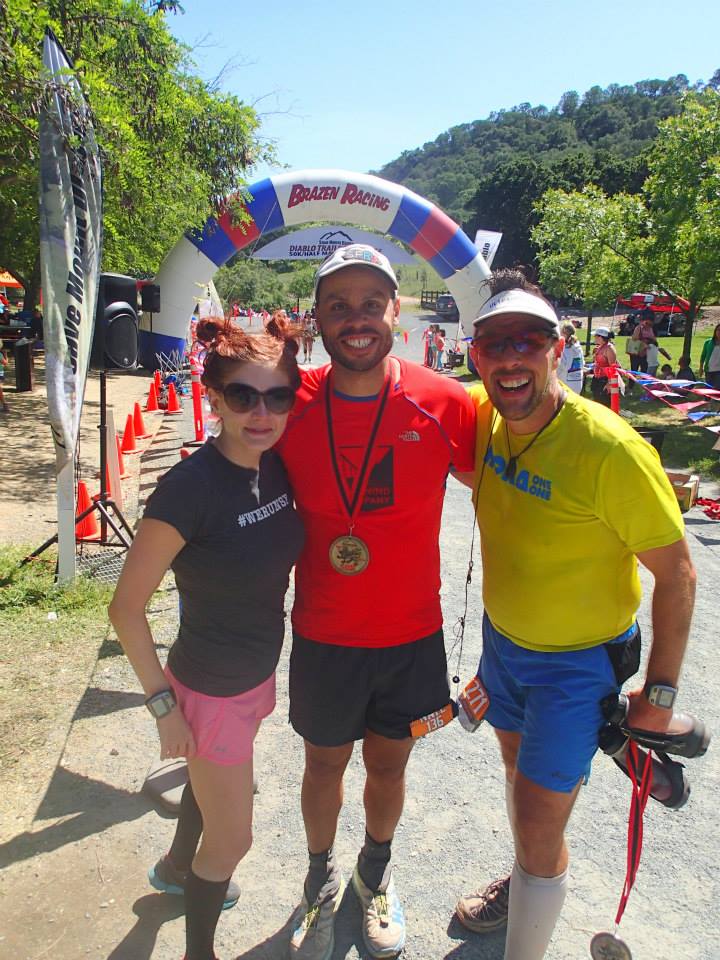
Friends at the finish line: Nate Dunn (center), Ken Michal (right) and someone new I met, Jessi Goldstein (left), who recognized me because of this blog! Photo by Alvin Lubrino
The finish line scene was a lot of fun. I got a free chair massage and then hung out with Victoria Wyatt while Bryan Wyatt and lots of friends finished. I really appreciated how Marty Breen of Forward Motion Sports in Danville annually sponsors this event for Save Mount Diablo and gives the top three finishers gift certificates.
Now in its fifth year, this 50K has developed into one of my favorite local trail races. Save Mount Diablo also puts on a family-friendly 5K/10K/half marathon with a similarly great finish-line picnic at Castle Rock Park in November. This year it’s November 2; check it out.
Now I’m feeling ready to taper and (almost) ready for the Miwok 100K on May 3.

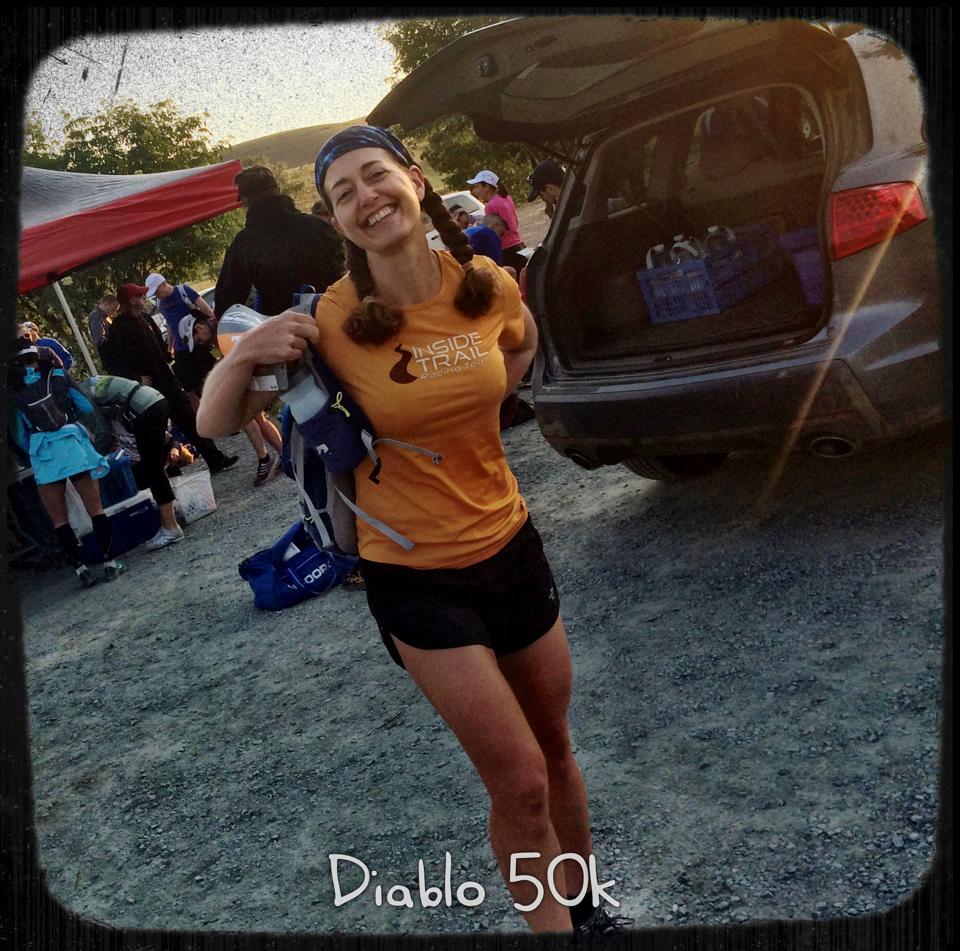
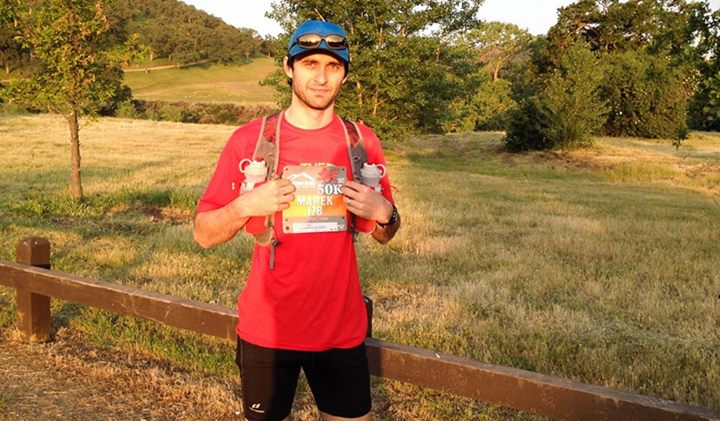
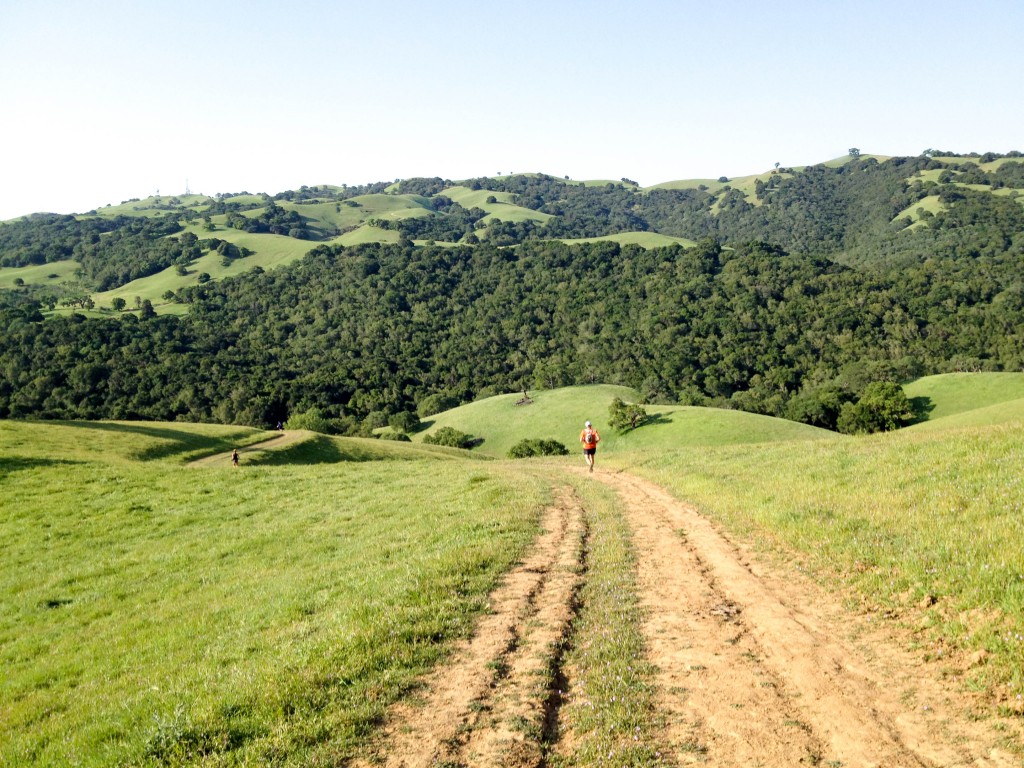
Very nice race report! Congrats on an excellet race. With that as a warm up for Miwok, you are sure to have a great experience there!
I love how you were able to actually treat this as a training run for most of the race, and then completely change gears when the opportunity presented itself. Congrats on a great finish – it was a blast seeing you finish and in such great shape. With your bib in your hand! Congrats and hopefully this means great things for Miwok.
Great report, Sar! A very smart run that was successful and effective both in terms of your training goals and your great finish! Hope you continue to feel good and strong on your way to May 3. XO
Nice run/race, Sarah! I did a long run on Diablo Friday – finished just about the time Brazen was starting to set up – and the green hillsides and flowers were just beautiful. You ran smart and it paid off. Sounds like, despite all the setbacks, you’ll be in great shape for Miwok!
What a gorgeous setting for a run. If I ever did one of these that would be the place. Don’t think it’s in the cards though. I’d be interested in hearing about your training regiment; is it on the website somewhere? Best of luck….